The Ethernet Storage Fabric Market is estimated to be valued at USD 2.3 billion in 2025 and is projected to reach USD 7.9 billion by 2035, registering a compound annual growth rate (CAGR) of 13.1% over the forecast period.
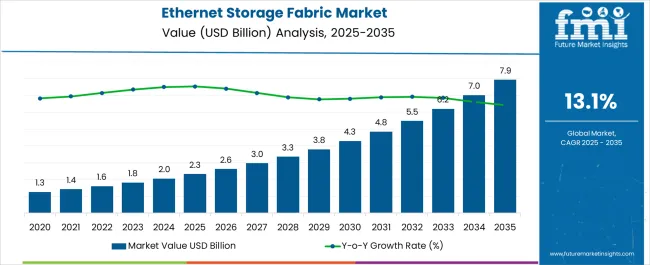
| Metric | Value |
|---|---|
| Ethernet Storage Fabric Market Estimated Value in (2025 E) | USD 2.3 billion |
| Ethernet Storage Fabric Market Forecast Value in (2035 F) | USD 7.9 billion |
| Forecast CAGR (2025 to 2035) | 13.1% |
The ethernet storage fabric market is experiencing steady expansion due to the rising need for high performance data storage solutions across enterprise and cloud environments. Growing adoption of artificial intelligence, machine learning, and big data analytics has intensified demand for scalable and low latency storage fabrics.
Enterprises are increasingly prioritizing architectures that ensure faster data transfer, minimal downtime, and seamless integration with modern workloads. Advancements in Ethernet technologies and greater adoption of non volatile memory express over fabrics are further accelerating market penetration.
Additionally, the cost effectiveness of Ethernet compared to traditional storage networking technologies is encouraging wider adoption. The future outlook remains positive as digital transformation initiatives and expansion of hyperscale data centers continue to drive investments in Ethernet storage fabrics across industries.
The market is segmented by Storage Type, Device, Switching Port, and Application and region. By Storage Type, the market is divided into Block Ethernet Storage Fabric, File Ethernet Storage Fabric, Object Ethernet Storage Fabric, and Hyper-converged Ethernet Storage Fabric Infrastructure. In terms of Device, the market is classified into Switches, Adapters, and Controllers. Based on Switching Port, the market is segmented into 10 GbE or 25 GbE, 40 GbE to 50 GbE, and 100 GbE and above. By Application, the market is divided into Enterprise Data Centers, Cloud Service Provider Data Centers, Telecommunications, and Government. Regionally, the market is classified into North America, Latin America, Western Europe, Eastern Europe, Balkan & Baltic Countries, Russia & Belarus, Central Asia, East Asia, South Asia & Pacific, and the Middle East & Africa.
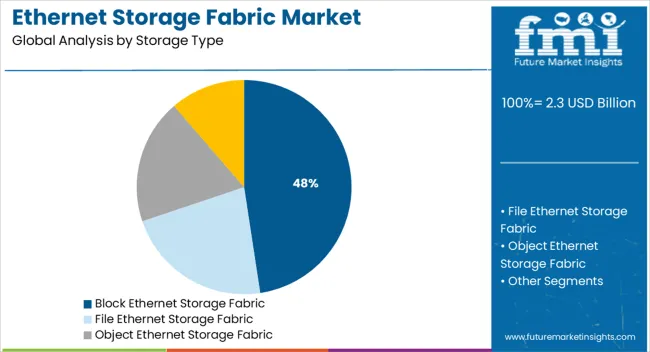
The block ethernet storage fabric segment is projected to contribute 47.60% of the overall revenue by 2025 within the storage type category, positioning it as the leading segment. Its dominance is being driven by the efficiency it provides in handling structured workloads, transaction heavy applications, and mission critical data environments.
Enterprises are leveraging block storage to ensure high speed input output operations, scalability, and predictable performance. Its compatibility with modern workloads and ability to provide flexible integration into data center infrastructures have further strengthened adoption.
As a result, block ethernet storage fabric continues to lead within the storage type category.

The switches device segment is expected to account for 53.20% of total revenue by 2025 within the device category, making it the most significant contributor. This growth is supported by the critical role switches play in providing high throughput, traffic management, and low latency connectivity across complex storage fabrics.
Switches have enabled enterprises to optimize bandwidth allocation and support virtualization and workload consolidation. Their flexibility in handling diverse data traffic while ensuring reliability and scalability has reinforced adoption.
As enterprises expand storage networks to meet evolving demands, switches remain indispensable, driving their leadership within the device segment.

The 10 GbE or 25 GbE switching port segment is anticipated to hold 42.90% of overall market revenue by 2025 within the switching port category, highlighting its strong position. Its leadership is attributed to the balance it offers between cost efficiency and performance scalability.
Enterprises are increasingly deploying 10 GbE and 25 GbE ports to handle rising data traffic and application workloads without incurring the high costs associated with higher bandwidth solutions. These ports provide sufficient throughput for medium to large scale data centers while allowing flexibility for future upgrades.
The segment’s dominance reflects its role as the preferred option for organizations seeking reliable, scalable, and cost effective Ethernet storage fabric solutions.
These are the times when every sector is trying to make the best use of data. It is only based on this data that product managers across the world are developing products to serve customers in the best possible manner. In such a scenario, the demand for ethernet storage fabric is expected to surge, as it helps in the effective transmission of data.
These are especially useful for SMEs, as the amount to be invested is quite low. However, owing to the number of disruptions because of the COVID-19 pandemic, the market witnessed tepid growth over the past couple of years. This has been reflected in the CAGR as well. While the historical CAGR for the market was a robust 17.3%, the anticipated CAGR is 13.1%.
Short Term (2025 to 2029): This period may be all about regaining the lost momentum. These may be particularly useful for start-ups because of the low investment. Apart from that, the ability to offer high bandwidth along with low latency is expected to drive growth.
Medium Term (2029 to 2035): During this period, the market might witness large businesses adopting this service over other alternatives. With technological upgrade, the Ethernet storage fabric is expected to handle larger volumes of data going further. Owing to this, they are expected to bring in lots of differences in the hyper-converged infrastructure.
Long Term (2035 to 2035): Owing to the growth of the IoT market, the seamlessness offered by ethernet storage fabric is expected to massively surge. The application with the help of IoT might ensure that the traffic systems are effectively utilized. Apart from that, data security is also expected to improve.
The high manufacturing expenses connected with the development of this technology and its accompanying goods may limit the market opportunity. Moreover, the dearth of trained professionals might act as a growth restraint for the market.
In addition, resistance to shifting from conventional technologies is expected to also create hindrances to the growth of the market. The high costs associated with the development and maintenance of ethernet storage fabric technology are expected to dampen the growth rate. The concerns about diverse vendor groups and their inability to adopt new technologies is predicted to hinder the market.
The expansion of data centers and growth in virtualization technology are the factors that are surging the demand, especially for 100 GbE and above. Moreover, 100 GbE and higher switching port-based solutions are backward-compatible, making implementation easier.
The overall growth and expansion of virtualization technologies are also expected to drive the growth. Surging applications in telecommunications, government, aerospace, oil, and gas, etc. are fueling the growth of the market.
Fiber channel usage is declining, whereas ethernet storage fabric adoption is increasing due to capabilities, like NVMe and 3D Xpoint SSDs. Any storage architecture or protocol, including hyper-converged infrastructure with rates ranging from 1 to 100 GB per second, can be supported by Ethernet storage fabric.
| Region | North America |
|---|---|
| Country | United States |
| CAGR (2025 to 2035) | 12.9% |
| Region | Europe |
|---|---|
| Country | United Kingdom |
| CAGR (2025 to 2035) | 12.1% |
| Region | Asia Pacific |
|---|---|
| Country | China |
| CAGR (2025 to 2035) | 12.5% |
| Region | Asia Pacific |
|---|---|
| Country | Japan |
| CAGR (2025 to 2035) | 11.5% |
| Region | Asia Pacific |
|---|---|
| Country | South Korea |
| CAGR (2025 to 2035) | 10.7% |
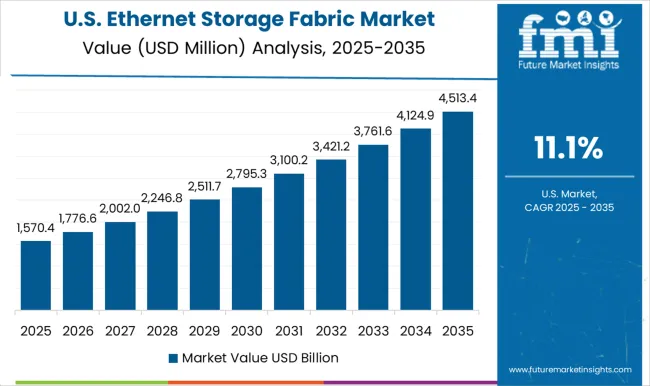
The United States is believed to be one of the most dominant data center markets. As per research reports, the data center market in the United States is expected to be valued at USD 7.9 billion by 2035.
The ethernet storage fabric is one of the most important components of the data center market. The ethernet storage fabric is optimized for handling massive traffic, and predictable performance to maximize data delivery. Apart from that, these also offer low latency, which ensures almost no data is lost and helps in crucial business storage environments.
| Attributes | Details |
|---|---|
| United States Market Expected Size (2035) | USD 2.3 billion |
| United States Market Absolute Dollar Growth | USD 1.6 billion |
| CAGR % 2020 to 2025 | 16.9% |
The United Kingdom is one of the leading cloud services markets. As per recent market research, the public cloud market is expected to surge beyond USD 30 billion by 2035. With the evolution of technology, ethernet storage fabrics are expected to bring about scalable solutions for data-driven applications.
The growth might be further fueled by the adoption of artificial intelligence, 5G technology, and NVMe storage disaggregation. These factors are expected to enhance the agility offered by businesses, thereby driving consumer growth.
| Attributes | Details |
|---|---|
| United Kingdom Market Expected Size (2035) | USD 273.5 million |
| United Kingdom Market Absolute Dollar Growth | USD 186.4 million |
| CAGR % 2020 to 2025 | 15.9% |
China is considered among the leading markets when it comes to AI and ML. As per the market research, the China Artificial Intelligence market is expected to be valued at USD 7.9 billion by 2035. The manufacturers of ethernet fabric storage make use of Artificial Intelligence to increase the efficiency of the systems. The application of AI ensures that the process achieves automation, as a result of which only some investment needs to be made at the time of installation. This coupled with the ability to work tirelessly owing to minimum human interference is expected to drive the market growth during the forecast period.
| Attributes | Details |
|---|---|
| China Market Expected Size (2035) | USD 466.4 million |
| China Market Absolute Dollar Growth | USD 322.2 million |
| CAGR % 2020 to 2025 | 16.5% |
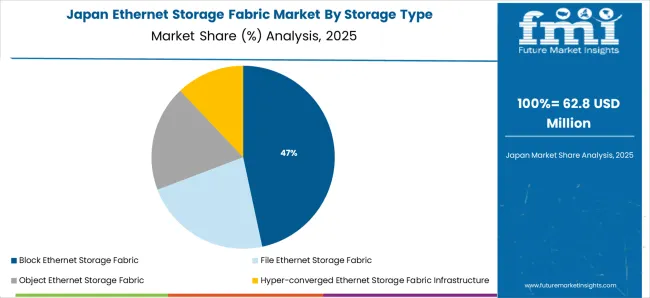
Japan is home to a highly sophisticated telecommunication market. The telecom players based out in Japan are facing high demand for ethernet storage fabric. The ability to offer remote direct memory access has grabbed a lot of eyeballs. Apart from that, ethernet storage fabric offers extremely agile, flexible, and cost-effective storage solutions, which has attracted a lot of investments from the telecommunication sector. These also enable effective and easy storage offloading, as a result of which not many cases of attenuation are noticed.
| Attributes | Details |
|---|---|
| Japan Market Expected Size (2035) | USD 381.2 million |
| Japan Market Absolute Dollar Growth | USD 2532. million |
| CAGR % 2020 to 2025 | 15.3% |
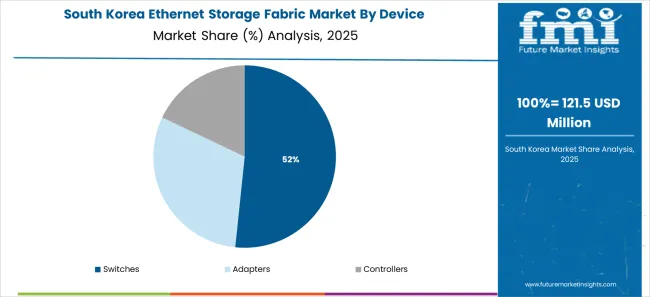
The South Korean government has been making some serious investments in technological upgrade. In 2025, the South Korea government released the ‘Digital New Deal’, which was all about investing USD 5.3 billion to upgrade the existing technological infrastructure.
Apart from that, government agencies have been specifically putting their money on ethernet storage fabric for its ability to deal effectively with a huge amount of data. The agencies are also counting upon the reliability offered by this technology, and how it represents a cost-effective solution.
| Attributes | Details |
|---|---|
| South Korea Market Expected Size (2035) | USD 224.3 million |
| South Korea Market Absolute Dollar Growth | USD 143.4 million |
| CAGR % 2020 to 2025 | 13.9% |
| Segment | Storage Type |
|---|---|
| Attributes | Block Ethernet Storage Fabric |
| CAGR (2020 to 2025) | 17.1% |
| CAGR (2025 to 2035) | 12.8% |
| Segment | Application |
|---|---|
| Attributes | Enterprise Data Centers |
| CAGR (2020 to 2025) | 16.8% |
| CAGR (2025 to 2035) | 12.6% |
The block ethernet storage fabric is expected to be highly preferred during the forecast period. The block ethernet storage fabric increases the processing speed, as it occupies less than 20% of the overall capacity.
This ensures low-level latency, as a result of which the efficiency increases by multifold times. The adoption of block ethernet storage fabric is known to outperform even fiber channels, which is expected to have a massive influence on the market. These make use of switches and adapters, which ensure zero packet loss.
Enterprise data centers are expected to hold the dominant market share. The increasing number of small and medium-scale enterprises and the adoption of digital technologies might further drive the demand for enterprise data centers.
The enterprise data centers are equipped to handle massive amounts of data, and this is provided without compromising the speed of ethernet storage fabric. These are also built on architectural solutions which are robust and dynamic. Moreover, the growth of the e-commerce sector is expected to have a huge impact on this segment, as growing e-commerce companies make use of this segment.
FThe key players operating in the market are providing unique storage capabilities, which enable switching fabric for data-centric performance. These may make use of Artificial Intelligence and Machine Learning for creating workloads that can be processed with faster performance.
Lightbits Labs: The start-up is meant for providing cost-effective means for higher performance. The company is a disaggregated storage provider, and one of the early adopters of NVMe/TCP. The start-up has been making use of ethernet to bring faster speeds from storage to host at a lower cost. Lightbits Labs is also a software-defined block storage vendor, which enables users to scale computing and storage separately. In June 2025, Lighbits Labs pulled in USD 42 million in funding, taking its net funding to USD 105.3 million.
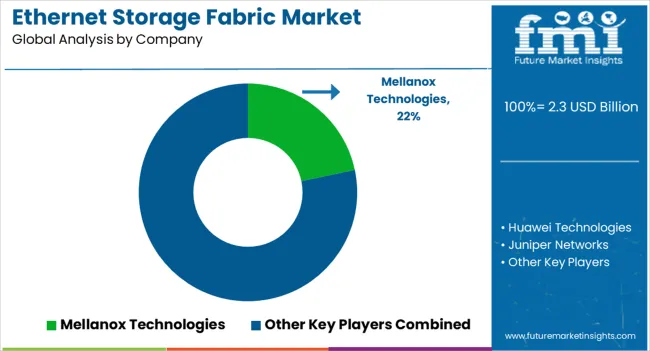
The key players are putting in the best resources to promote Optical Access Technologies. The industry has been adopting practices wherein broadband networks might be adopting all-optical access to increase data security. All this has been possible through the implementation of Virtual Reality and Augmented Reality. In February 2025, STC and Huawei accomplished the first 50G PON live trial in Saudi Arabia.
Key developments in the market
Dominant players in the market
| Company | Description |
|---|---|
| Huawei | Huawei is the leading global provider of Information and Communications technology infrastructure and smart devices. The company has been employing more than 195,000 workers worldwide and provides operations in 170 countries. The company’s mission is to bring digital to every person, home, and organization for a fully connected world. Huawei has believed in driving ubiquitous connectivity and promoting equal access to networks. The company has always remained in favor of openness and collaboration for shared success. |
| Juniper Networks | Juniper Networks has always believed in delivering network experiences that transform how people connect, work, and live. By challenging the complexities of 5G and the cloud, the company has been providing solutions to the connections that matter the most. The company has always pursued simplicity. Juniper Networks is obsessed with exceptional quality and remarkable customer experience. Even after achieving the goal, the company is looking for ways to enhance customer experience. |
| Arista Networks | Arista Networks is the market leader in data-driven, client-to-cloud networking for data center, campus, and routing environments. The platforms delivered by the company have been providing availability, agility, automation, analytics, and security through the network operating stack. Arista’s core technologies have transformed them into a data-driven cognitive cloud networking company that delivers its Artificial Intelligence value through a network. |
Other significant players profiled: Mellanox Technologies and Hewlett Packard Enterprise Company.
The global ethernet storage fabric market is estimated to be valued at USD 2.3 billion in 2025.
The market size for the ethernet storage fabric market is projected to reach USD 7.9 billion by 2035.
The ethernet storage fabric market is expected to grow at a 13.1% CAGR between 2025 and 2035.
The key product types in ethernet storage fabric market are block ethernet storage fabric, file ethernet storage fabric, object ethernet storage fabric and hyper-converged ethernet storage fabric infrastructure.
In terms of device, switches segment to command 53.2% share in the ethernet storage fabric market in 2025.






Full Research Suite comprises of:
Market outlook & trends analysis
Interviews & case studies
Strategic recommendations
Vendor profiles & capabilities analysis
5-year forecasts
8 regions and 60+ country-level data splits
Market segment data splits
12 months of continuous data updates
DELIVERED AS:
PDF EXCEL ONLINE
Ethernet Connector and Transformer Market Size and Share Forecast Outlook 2025 to 2035
Ethernet Backhaul Equipment Market Size and Share Forecast Outlook 2025 to 2035
Ethernet Access Device Market Size and Share Forecast Outlook 2025 to 2035
Ethernet Switch Market
Ethernet Storage Market Size and Share Forecast Outlook 2025 to 2035
TSN Ethernet Chips Market Size and Share Forecast Outlook 2025 to 2035
Power Over Ethernet (PoE) Controllers Market Size and Share Forecast Outlook 2025 to 2035
Industrial Ethernet Market Size and Share Forecast Outlook 2025 to 2035
Power Over Ethernet (PoE) Solutions Market Size and Share Forecast Outlook 2025 to 2035
PoE Solutions Market - Growth, Demand & Forecast 2025 to 2035
In-Vehicle Ethernet System Market Growth – Trends & Forecast 2025 to 2035
SP Routing And Ethernet Switching Market Size and Share Forecast Outlook 2025 to 2035
Storage Water Heater Market Size and Share Forecast Outlook 2025 to 2035
Storage Tank Equipment Market Size and Share Forecast Outlook 2025 to 2035
Storage And Handling Equipment Market Size and Share Forecast Outlook 2025 to 2035
Storage Area Network (SAN) Market Analysis by Component, SAN Type, Technology, Vertical, and Region through 2035
Storage as a Service Market Trends – Growth & Forecast 2020-2030
Storage Virtualization Market
Oil Storage Market Size and Share Forecast Outlook 2025 to 2035
LNG Storage Tank Market Growth - Trends & Forecast 2025 to 2035

Thank you!
You will receive an email from our Business Development Manager. Please be sure to check your SPAM/JUNK folder too.
Chat With
MaRIA